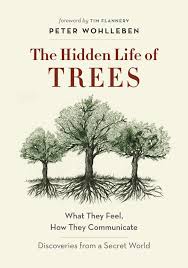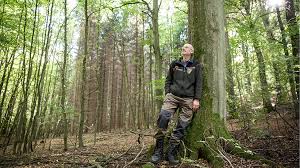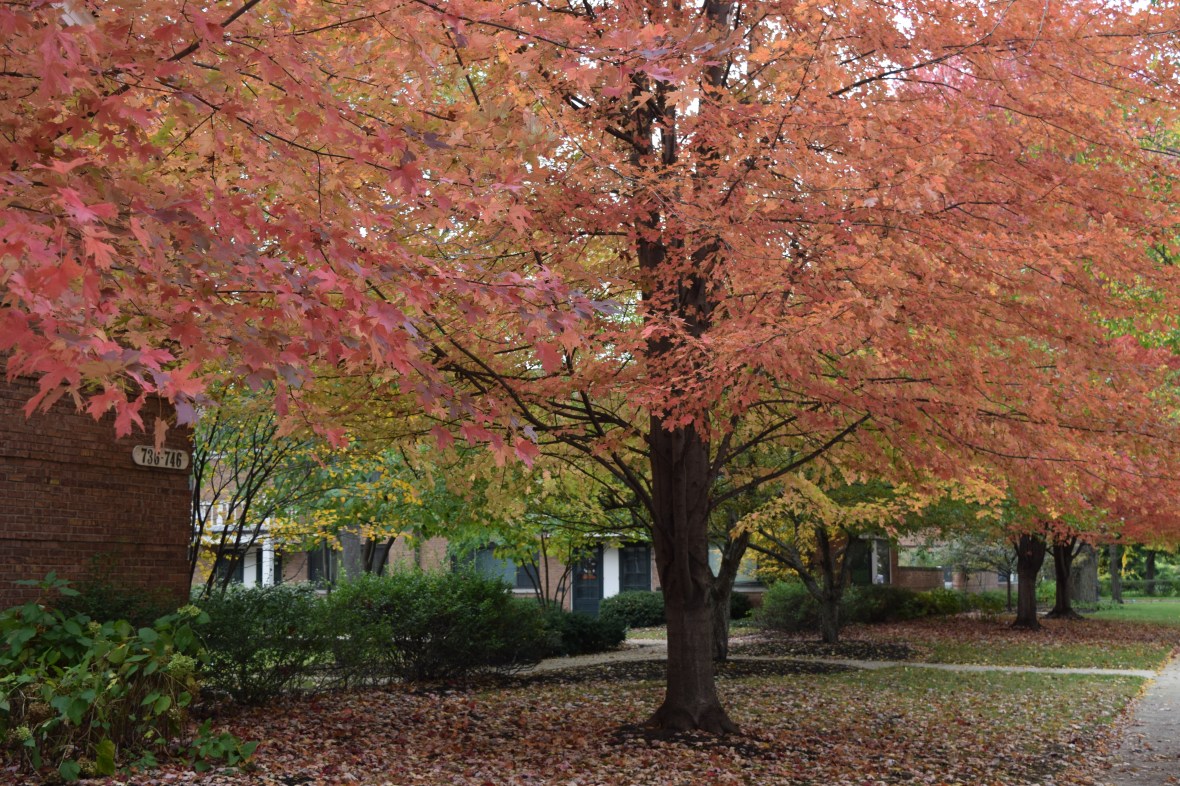Book Review: The Hidden Life of Trees, by Peter Wohlleben
I loved this book. I would have to say it is the best book on the science of plants that I have ever read.

Wohlleben, a forest manager in Germany, feels an intimate connection with trees, and he lets you share in that intimacy. What’s more, Wohlleben helps his readers to see trees in a fundamentally different way.
Most interesting to me is how trees, or at least the beeches and other species that the author focuses on, are really social beings. Trees are healthiest and most long-lived when they live in close physical association with other trees. The practice of “thinning” trees to let them grow to their full potential size is actually harmful, according to the author.
In fact, trees have their own form of social security through which resources (in this case, the sugar produced by photosynthesis) are equally distributed among members of the forest community. (Trees are socialists! Someone call Sean Hannity!) They do this through the “wood wide web”, a network of fungi that connects the roots of trees, facilitating redistribution and a kind of communication as well.

Trees also provide mutual aid to each other in the case of physical injury or attack by fungi or insects.
This book made me rethink my view of trees as passive, almost inanimate objects. In fact, trees are, as individuals and in groups, active players in a life-and-death drama. People, myself included, are usually blind to the drama because it unfolds in tree time, which is to say very, very slowly. As Wohlleben says, “trees live life in the slow lane”.

Trees must divide their energy between growth and producing the chemical weapons that keep insects, fungi, and other dangers at bay. Wohlleben has interesting things to say about these compounds, or phytoncides, which have antibiotic qualities. The phytoncides of conifers are especially pungent, and are the source of the unique scent of evergreen forests.
I could go on, but I’ll just conclude that The Hidden Life of Trees is a fun and fascinating read.





I’ve heard this book is amazing!!
I would recommend it highly.
This sounds great. I’ve added it to my list!
We just read this book here at the nursery as well! great book, amazing understanding of the inter-connectedness of trees and the forest. A must-read for gardeners and naturalists and everyone else!
I agree!
I’ve heard of this book, it is an international bestseller. It sounds fascinating. You’ve convinced me, I have ordered it.
Enjoy!
I saw a program on Canadian TV on this subject. Fascinating! Some spruce trees do not produce seed cones In some years in an attempt to starve squirrels and reduce their population.
Reducing the squirrel population is a project I can totally get behind.
I’ve read this, and concur with your review. It really was eye-opening, and enjoyable, too.
Wow! The book sounds like a “must-read”. Thanks for recommendation.
Thanks for the good review.
And thanks for the photo of one of our beautiful “Autumn Blaze” maples in front of Elm Tree Village. As you must have seen, we lost one of our four remaining elms last year, but are planning a replacement, probably with another Autumn Blaze. They are gorgeous in full color.
Those trees are real beauties in autumn.
I haven’t read it (need to!), but I’ve heard people reference it in presentations. All that mycorrhizal and bacterial life under the soil, and the chemical interactions–fascinating stuff!
Sounds fascinating!
Hello Jason, I think it’s only recently that we discovered most of the action is below ground when it comes to trees in the way they interconnect through fungi. It’s difficult to appreciate and understand as it’s just not visible. I might just have to start a Wishlist as I keep saying, “oh, I must look into that sometime”.
It’s fascinating stuff, and helps us understand how to care for the parts of the plants above ground.
I think I have seen this book played out in a documentary on tv. It is fascinating. I have a book similar to read _The Living Forest_ by Joan Maloof.
That also sounds good.
I heard this book reviewed on the radio last year and thought it sounded intriguing but I’ve yet to read it. It really does raise some fascinating points. There’s still so much we don’t know about the effects of bacteria, viruses and fungi on all living things.
It’s nice to know there’s so much still to explore about plants and soil.
I read this a while ago and agree, it is a wonderful book. Also try Urban Forests by Jill Jonnes and The Forest Unseen by David George Haskell. I could go on. Is it obvious my favorite plant is trees?
Thanks for those recommendations! I’ll add them to my to be read list.
This book sounds amazing. I will definitely be reading it within the next couple of weeks! Thanks for the review.
I think you’ll enjoy it.
I really enjoyed this book so much that I also listened to it on my Kindle and gleaned even more from it. A very deep book indeed.
Yes, it’s worth a second read, or listen.
I’m glad to hear that. I bought it a week or two ago but haven’t read it yet.
I’ve heard about this book, and now you’ve convinced me to get a copy. I love the idea of how connected they are, and that they kind of tree socialists….we have so much to learn from the world around us. I hope our apple tree will forgive us for trimming it, but to have a tree in suburban without trimming is impossible.
I think sometimes trees need trimming to stay healthy.
True…and you if you have possums setting up home in one.
This book reminds me of an article that ended with a quote from a scientist stating that plants are just really slow animals. The community aspect of trees is new to me though and fascinating!
Plants are slow animals – I like that!
This was a very enjoyable post to read. Maybe this is why I always mourn when we have to remove a tree from the property. We’ve taken three down in the last few years because they all were in danger of coming down in a storm. Even knowing that, I felt like I lost an old friend.
Losing a tree is always sad.
I received this book as a Christmas gift and am going very slowly (not quite tree time) and savoring every word.
A book worth savoring, maybe a second read.
This has been on best seller lists here for over 12 months now and I still haven’t got a copy! Thanks for your review – it has encouraged me to put it on my reading list. 🙂
You would love it! Plus you could read it in the original German.
This sounds like a must read! I recently watched Judy Dench and the mysterious life of trees, a stunning production. I was spellbound.xxx
I think you would love this book.
I’m still working my way through The Songs of Trees by David George Haskell but I have this one too and look forward to reading it (thanks for reminding me!). I have always felt a personal connection to my trees and I think my Redbud knows I love it. It makes perfect sense that trees are connected to each other, when trees have symbiotic relationships with other life forms.
That Haskell book sounds interesting.
I fell in love with his writing reading “The Forest Unseen: A Year’s Watch in Nature.”
Thanks for sharing! Definitely one to look out for.
Hi. I think my comments on your blog might be going into your spam folder.
Uh-oh. Do we have a spam folder in WP? I’ll like this and see if it makes a difference?
I too found the book enchanting and reviewed it on my own blog last year. Hope its ok to give my link http://www.nodiggardener.co.uk/search?q=secret+life+of+trees
Of course.
My husband read this and thought it was ver interesting.
I bought this today! So I skipped some of your post in case of spoilers but I will come back and read it in it’s entirety 😀
Enjoy the book!
Great review…just started it. A nice gift from a friend. Fascinating!
Yes, it’s a wonderful book.
Sounds like a fascinating book to read and understand crucial part of the worlds ecosystem.
I found these books also pretty interesting to read especially because it helped me understand the world around me and understand myself.
https://innerapex.wordpress.com/category/books/
I just finished reading it. It was a real eye- opener for me. His love and appreciation for nature is apparent. I posted a short review of the book on Aergia’s Daughter.
I’ll take a look.